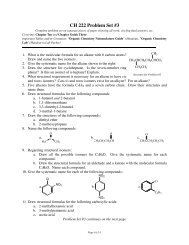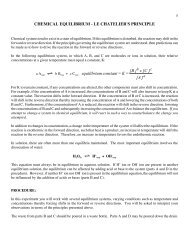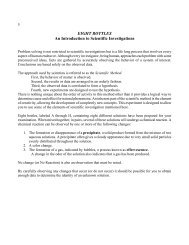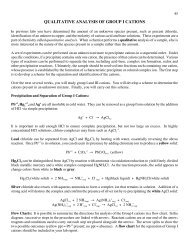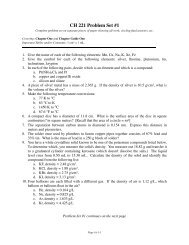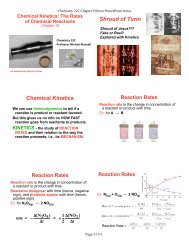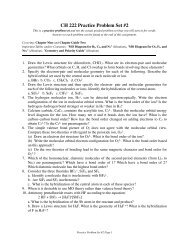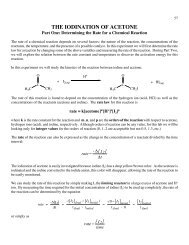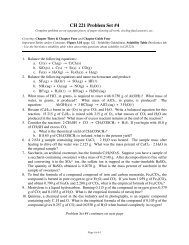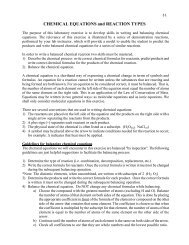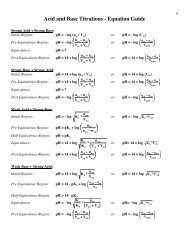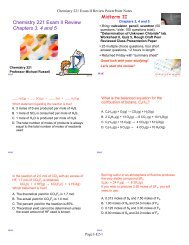Determination of an Equilibrium Constant
Determination of an Equilibrium Constant
Determination of an Equilibrium Constant
You also want an ePaper? Increase the reach of your titles
YUMPU automatically turns print PDFs into web optimized ePapers that Google loves.
1<br />
DETERMINATION OF AN EQUILIBRIUM CONSTANT<br />
In this experiment the equilibrium properties <strong>of</strong> the reaction between the iron(III) ion <strong>an</strong>d the thiocy<strong>an</strong>ate ion will be<br />
studied. The relev<strong>an</strong>t chemical equation for this lab is:<br />
Fe +3 (aq) + SCN - (aq) qe FeSCN +2 (aq)<br />
[ +2<br />
FeSCN ]<br />
K c =<br />
[ +3<br />
Fe ][ -<br />
SCN ]<br />
When solutions <strong>of</strong> Fe +3 <strong>an</strong>d SCN - are mixed, the above reaction occurs to some extent, forming the complex ion<br />
FeSCN +2 . The concentrations <strong>of</strong> Fe +3 <strong>an</strong>d SCN - will decrease by one mole for every mole <strong>of</strong> FeSCN +2 that forms,<br />
but not all <strong>of</strong> the Fe 3+ <strong>an</strong>d SCN - ions will be converted to the complex ion under normal circumst<strong>an</strong>ces.<br />
The objective <strong>of</strong> this experiment is to determine the equilibrium const<strong>an</strong>t, K c , for this reaction. The value <strong>of</strong> K c is<br />
const<strong>an</strong>t at a given temperature. Any mixture <strong>of</strong> Fe +3 <strong>an</strong>d SCN - will react until the same value <strong>of</strong> K c is obtained. In<br />
this experiment, we will determine K c for this reaction using several different mixtures <strong>of</strong> Fe +3 <strong>an</strong>d SCN - .<br />
Before we c<strong>an</strong> calculate the value <strong>of</strong> the equilibrium const<strong>an</strong>t, we must be able to determine the concentration <strong>of</strong><br />
FeSCN +2 in solution. The Beer-Lambert Law, which is commonly referred to as simply Beer's Law, relates the<br />
absorption <strong>of</strong> light in a colored sample to its concentration in solution:<br />
A = εbc = log (100% / %T)<br />
Here A is the measured absorb<strong>an</strong>ce <strong>of</strong> the colored solution, ε is the molar absorptivity (with units <strong>of</strong> M -1 cm -1 ), b is<br />
the path length (in cm), <strong>an</strong>d c is the concentration (molarity, or moles per Liter) <strong>of</strong> the species being studied, in this<br />
case FeSCN +2 . The value <strong>of</strong> the molar absorptivity, ε, depends on the solute's overall energy stored within the<br />
molecule. FeSCN 2+ has a deep red color while the react<strong>an</strong>ts are virtually colorless, <strong>an</strong>d only FeSCN 2+ will absorb<br />
light in the visible region.<br />
Absorb<strong>an</strong>ce is a unitless qu<strong>an</strong>tity that corresponds with the amount <strong>of</strong> light removed by a colored system. We will<br />
be using <strong>an</strong>alog Spectronic 21 instruments that determine the percent tr<strong>an</strong>smitt<strong>an</strong>ce (%T), or how much light gets<br />
through colored solutions. Calculating absorb<strong>an</strong>ce from %T is straightforward (A = log (100%/%T).<br />
Because FeSCN +2 has a red color, we will use a wavelength appropriate for measuring red light (450 nm). Using<br />
the Beer's Law equation, we c<strong>an</strong> determine the molar absorptivity const<strong>an</strong>t, ε, for FeSCN +2 by measuring its<br />
absorb<strong>an</strong>ce at different known concentrations <strong>of</strong> FeSCN 2+ . If absorb<strong>an</strong>ce is plotted versus concentration, the slope<br />
will give the molar absorptivity const<strong>an</strong>t using Beer's Law.<br />
Finding the concentration <strong>of</strong> FeSCN +2 c<strong>an</strong> be achieved using Le Chatelier's Principle. If <strong>an</strong> excess <strong>of</strong> Fe 3+ is added<br />
to a small amount <strong>of</strong> SCN - , one c<strong>an</strong> assume that the amount <strong>of</strong> SCN - present in solution equals the amount <strong>of</strong><br />
FeSCN 2+ formed at equilibrium. In other words, we know the final concentration <strong>of</strong> FeSCN +2 in the solution by<br />
creating a solution that is not in equilibrium but goes to completion using the principle <strong>of</strong> limiting reagent. The<br />
SCN - will be completely converted to FeSCN +2 , such that the final concentration <strong>of</strong> FeSCN +2 is equal to the initial<br />
concentration <strong>of</strong> SCN - .<br />
The purpose <strong>of</strong> this lab is to find the value <strong>of</strong> the equilibrium const<strong>an</strong>t, K c . First, you will prepare a series <strong>of</strong><br />
solutions with known concentrations <strong>of</strong> FeSCN 2+ (or SCN - ) <strong>an</strong>d measure the absorb<strong>an</strong>ce values at 450 nm using a
2<br />
Spec 21. When the absorb<strong>an</strong>ces are plotted versus the concentration <strong>of</strong> FeSCN 2+ , a linear relationship appears, <strong>an</strong>d ε<br />
c<strong>an</strong> be calculated using linear regression (the slope equals εb.). Remember to report the value <strong>of</strong> the slope, y-<br />
intercept <strong>an</strong>d correlation coefficient when using linear regression. ε will allow you to calculate the concentration <strong>of</strong><br />
FeSCN 2+ for <strong>an</strong>y combination <strong>of</strong> Fe 3+ <strong>an</strong>d SCN - . You will then prepare a series <strong>of</strong> solutions with varying amounts <strong>of</strong><br />
Fe 3+ <strong>an</strong>d SCN - initially present, measure the absorb<strong>an</strong>ce for FeSCN 2+ , <strong>an</strong>d determine the value <strong>of</strong> K c at room<br />
temperature.<br />
PROCEDURE:<br />
In Part A, the goal is to find the molar absorptivity const<strong>an</strong>t, <strong>an</strong>d in Part B, you will find the value <strong>of</strong> the equilibrium<br />
const<strong>an</strong>t. Both parts use similar techniques, but make sure you use the correct concentrations in each section.<br />
Check <strong>an</strong>d double-check the concentrations before <strong>an</strong>alyzing your solutions!<br />
Before you leave lab, it is import<strong>an</strong>t that you share data with the other group (essentially mL <strong>of</strong> KSCN <strong>an</strong>d %T<br />
values). Also make sure to get all <strong>of</strong> the names <strong>of</strong> your lab partners from both groups.<br />
Part A: Determining the Molar Absorptivity Const<strong>an</strong>t (ε)<br />
Place approximately 30 mL <strong>of</strong> 0.100 M Fe(NO 3 ) 3 in 1 M HNO 3 in a dry labeled 100 mL beaker. The HNO 3 allows<br />
the solute components to remain in solution, but it does not affect our calculations in this lab. Note also that there<br />
are two different stock solutions <strong>of</strong> Fe(NO 3 ) 3 <strong>an</strong>d KSCN at different concentrations. Make sure you choose the<br />
correct solution for part A or your experiment will not work!<br />
Place approximately 20 mL <strong>of</strong> 3.00 x 10 -4 M KSCN into a second dry labeled 100 mL beaker. Cle<strong>an</strong> <strong>an</strong>d dry six 16<br />
x 150 mm test tubes <strong>an</strong>d label 1-5 <strong>an</strong>d B (bl<strong>an</strong>k).<br />
Pipet 5.00 mL <strong>of</strong> the Fe(NO 3 ) 3 solution into tubes 1-5. Pipet 1, 2, 3, 4, or 5 mL <strong>of</strong> KSCN into the corresponding<br />
labeled test tube. Then add the correct number <strong>of</strong> mL <strong>of</strong> water to each test tube so that the total volume is 10.00 mL.<br />
The sixth test tube is the bl<strong>an</strong>k <strong>an</strong>d will contain only water.<br />
Determine the %T for each <strong>of</strong> the five solutions using a Spec 21 at 450 nm. Assume the path length, b, equals 1.00<br />
cm for these trials. Convert the %T readings into absorb<strong>an</strong>ce. Recall that A = log(100%/%T). You should see a<br />
linear relationship between mL <strong>of</strong> KSCN added <strong>an</strong>d Absorb<strong>an</strong>ce; if not, you might w<strong>an</strong>t to re-do the measurements.<br />
Dispose <strong>of</strong> the solutions in the waste bottle when complete.<br />
On your data page, determine the initial molarity <strong>of</strong> Fe +3 <strong>an</strong>d <strong>of</strong> SCN - present in each solution using the dilution<br />
equation (M i x V i = M f x V f ).<br />
Example: Find the concentration <strong>of</strong> SCN - when 20.0 mL <strong>of</strong> a 1.50 * 10 -4 M KSCN is diluted with 0.1 M<br />
HNO 3 to 25.0 mL.<br />
Solution: The initial concentration <strong>of</strong> KSCN, 1.50 * 10 -4 M, is being diluted with nitric acid to a new<br />
solution volume <strong>of</strong> 25.0 mL. We c<strong>an</strong> use M i x V i = M f x V f equation <strong>an</strong>d solve for M f .<br />
M f = 1.50 * 10 -4 M * 20.0 mL / 25.0 mL = 1.20 * 10 -4 M<br />
Find the concentration <strong>of</strong> FeSCN 2+ using the law <strong>of</strong> limiting react<strong>an</strong>ts.<br />
Example: Find the concentration <strong>of</strong> FeSCN 2+ when [SCN - ] = 1.20 * 10 -4 M <strong>an</strong>d [Fe 3+ ] = 0.100 M.
Solution: Since [SCN - ]
4<br />
POSTLAB QUESTIONS:<br />
1. A student mixes 5.00 mL <strong>of</strong> 2.00 x 10 -3 M Fe(NO 3 ) 3 with 5.00 mL 2.00 x 10 -3 M KSCN. She finds that in the<br />
equilibrium mixture the concentration <strong>of</strong> FeSCN +2 is 1.40 x 10 -4 M.<br />
a. What is the initial concentration in solution <strong>of</strong> the Fe +3 <strong>an</strong>d SCN - ?<br />
b. What is the equilibrium const<strong>an</strong>t for the reaction?<br />
2. Assume that the reaction studied is actually: Fe +3 (aq) + 2 SCN - (aq) qe Fe(SCN) 2<br />
+(aq)<br />
a. What is the equation for determining the equilibrium const<strong>an</strong>t?<br />
b. Using the information from question 1 <strong>an</strong>d assuming [Fe(SCN) 2 + ] = 1.40 x 10 -4 M, calculate the equilibrium<br />
concentration <strong>of</strong> Fe +3 <strong>an</strong>d SCN -<br />
c. Determine the numerical value <strong>of</strong> K.



